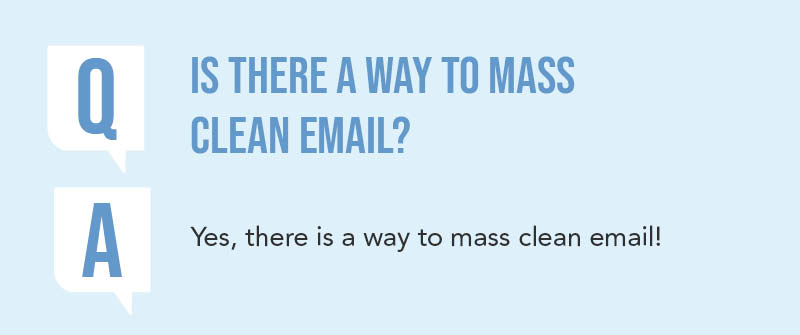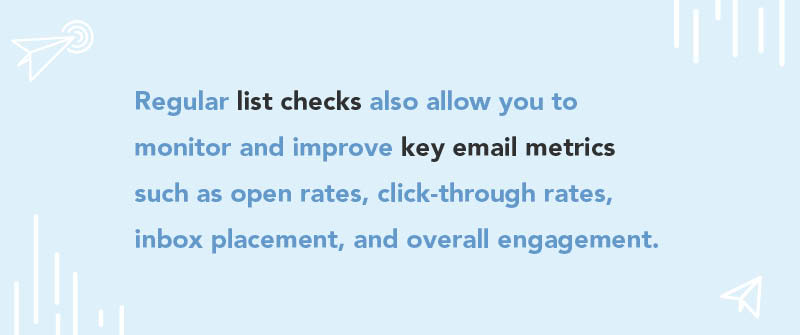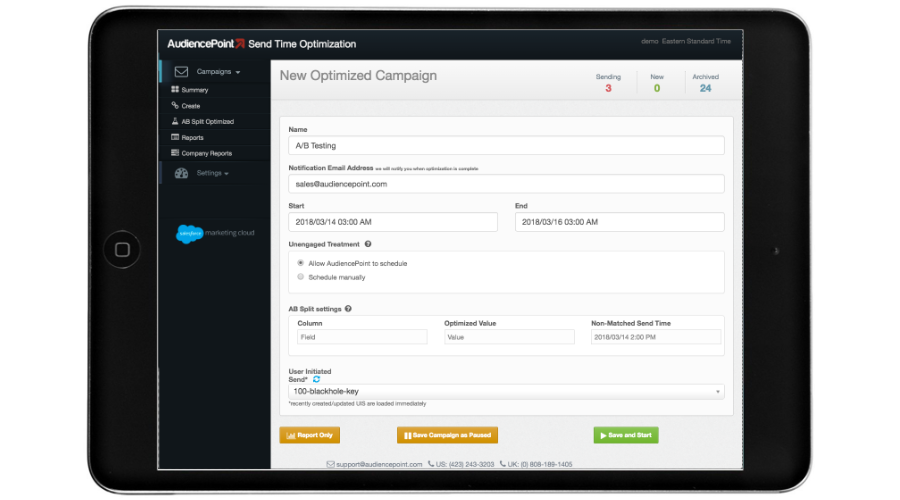AudiencePoint is thrilled to announce our new integration with Klaviyo! AudiencePoint is looking for partners to pilot our...
What Does It Mean To Scrub A Mailing List?
Email scrubbing refers to the essential process of removing inactive or invalid email addresses from your mailing list. It’s a critical part of maintaining a high quality email list. By ensuring the emails on your list are valid, you improve deliverability, reduce bounce rates, and enhance overall engagement. In essence, scrubbing a mailing list means purging it of emails that no longer serve your marketing objectives.
How to Scrub an Email List: Definition and Importance of Email List Scrubbing
The process of email scrubbing is akin to regular maintenance. Using sign up forms that incorporate double opt in and email validation helps ensure only engaged and valid subscribers are added to your list. As you accumulate email addresses over time, not all of them remain valid or engaged. People change email addresses, unsubscribe, or even provide temporary addresses that become outdated. By regularly cleaning your list, you ensure you are communicating with and investing in subscribers who are genuinely interested in your content.
Common Issues: Email Scrubbing Addresses
Ineffective email lists lead to multiple issues such as high bounce rates, email bounces, duplicate emails, and problematic email addresses including fake email addresses and invalid addresses, reduced sender reputation, and emails landing in spam folders. These factors harm your ability to reach your audience effectively. Emails bounce when sent to invalid addresses, and a high bounce rate can damage your sender reputation. Email list scrubbing specifically targets these issues by eliminating problematic addresses such as spam traps and duplicate emails, before they can impact your metrics negatively.
Benefits Of Maintaining A Clean Email List
Maintaining a clean email list comes with a host of benefits. Firstly, it ensures high email deliverability, meaning more of your emails reach their intended recipients rather than bouncing back or landing in spam. Secondly, it improves your sender reputation, as ISPs (Internet Service Providers) regard businesses with cleaner, more engaged email lists more favorably. This leads to better inbox placement rates, which can vastly increase open and engagement rates—an essential factor for maximizing email marketing ROI. Moreover, a well-maintained list enables more accurate analytics, helping fine-tune future campaigns. Lastly, from a compliance perspective, it ensures adherence to regulations such as GDPR, which protects consumer data privacy.
Including an unsubscribe link and allowing subscribers to update their email preferences helps ensure compliance with regulations such as CAN-SPAM, leads to fewer spam complaints, and supports a good sender reputation.

How To Scrub An Email List For Free
Email scrubbing is an essential practice for any email marketing professional. You can use a free email verification service, email validation service, or email list cleaning service to help identify and remove invalid or risky addresses from your list. It involves cleaning your email list by removing inactive or invalid email addresses, which helps improve deliverability rates and enhances your email campaign’s overall performance. A clean list ensures that your messages reach active and engaged subscribers, which can lead to higher conversion rates and a better return on investment. Many email list cleaning services offer free tools or trials to help you get started.
Using Free Tools And Methods To Clean Your List
There are several ways to clean your email list without incurring any costs. Free tools can be incredibly effective, offering functionalities that automate parts of the scrubbing process. Some popular options include NeverBounce, ZeroBounce’s free version, and Mailchimp’s built-in cleaning features. Many email verification services and email validation services offer real time verification and deliverability tools, and can integrate with platforms like Google Sheets to streamline the cleaning process. These tools generally provide basic insights and allow for the manual identification of inactive subscribers, hard bounces, and spam complaints. They can also help you identify and remove duplicate contacts from your list.
In addition to automated tools, you can manually clean your list by monitoring engagement metrics such as open and click-through rates. Manually sending re-engagement emails to dormant subscribers can further aid in determining which emails should be removed.
Manual Vs. Automated Scrubbing Processes
The choice between manual and automated scrubbing depends largely on the size of your email list and the resources available. Manual scrubbing is often labor-intensive and more feasible for smaller lists, as it involves a detailed review of each email address’s activity. On the other hand, automated tools save time and provide quicker, more accurate results, especially for larger lists.
Automated scrubbing tools are programmed to detect patterns and anomalies. Marketing automation features within your email marketing platform, or those offered by email service providers, can help automate the process of cleaning and segmenting your email list. By leveraging these tools, you can maintain a healthier list and focus on crafting effective email content.
Steps To Ensure Effective List Scrubbing
Effective email scrubbing starts with setting a regular schedule for maintenance. You should establish clear criteria for inactivity and create a re-engagement campaign to confirm whether subscribers are genuinely disinterested. Sending a targeted re-engagement email can help re-engage inactive subscribers and identify inactive subscribers for removal. Use suppression lists to manage and remove contacts that harm deliverability rates. This includes removing inactive subscribers, bounced email addresses, and problematic email addresses such as fake email addresses, spam email addresses, and disposable email addresses.
Regularly update and validate your list using the free tools available. These tools can help you identify and remove invalid email addresses, invalid addresses, invalid emails, and catch all domains. Monitor your email campaign metrics closely. Track subscriber count and email subscribers to ensure you are only sending emails to active email accounts.
The goal is not just to remove inactive subscribers but also to positively influence your sender reputation, which ultimately enhances inbox placement. Removing bounced emails and sending welcome emails to new subscribers can help maintain a healthy list. With a tool like AudiencePoint, you can leverage unparalleled insights that can transform your inbox placement rates by suppressing spam folder landings and improving deliverability. Only sending emails to valid and engaged subscribers helps avoid spam emails and improves deliverability.
Is There A Way To Mass Clean Email?
Yes, there is a way to mass clean email, and it involves using bulk email verification tools that offer a reliable and efficient method to verify large lists of email addresses. These tools automate the time-consuming task of checking each email address, ensuring that your email marketing efforts are not hampered by outdated or invalid email data. Mass cleaning supports more effective email marketing campaigns, improves email marketing performance, and helps you track key email metrics such as open rates, click-through rates, and engagement.

Overview Of Bulk Email Verification Tools
Bulk email verification tools are designed to rapidly process extensive email lists, identifying invalid, inactive, or potentially harmful addresses. Email verification services and email validation services, including those offered by email list cleaning services, provide features such as real time verification, detection of catch all domains, role based emails, temporary emails, and spam traps. These tools use algorithms and databases to verify the syntax and domain validity of email addresses, check for known spam traps, and eliminate free or disposable emails and spam trap addresses using advanced deliverability tools. By relying on these automated processes, companies can significantly reduce the time and labor required to maintain email list hygiene.
For organizations that need to analyze second-party data, platforms like Constant Contact also offer integrations with email verification service providers to enhance list hygiene.
Key Features And Functionalities
Improperly formatted email addresses are quickly identified and corrected, ensuring accuracy throughout your database. These tools also help remove duplicate email addresses, duplicate emails, and bounced email addresses to maintain a clean and effective list. Known spam traps and invalid MX records are flagged, preventing emails from being sent to notorious domains or bouncing due to invalid domain details. They also remove bounced emails, invalid email addresses, invalid addresses, invalid emails, and problematic email addresses such as spam email addresses, fake email addresses, and disposable email addresses. Additionally, these tools can detect role-based emails such as ‘info@’ or ‘sales@,’ commonly associated with non-engagement.
A unique advantage of tools like AudiencePoint lies in their ability to analyze second-party data, providing extra insight into an email’s activity across various platforms. These tools can also help manage and clean up inactive or unused email accounts, ensuring your subscriber list remains engaged and authentic. This functionality ensures that not only is the email address valid, but it is also active, thus enhancing email campaign engagement metrics.
Case Study Example On Successful Mass Email Cleaning
A financial services company struggled with declining email open rates and suspected that poor list quality was the issue. By implementing a comprehensive bulk email verification process using AudiencePoint, they were able to cleanse their email list of inactive and suspicious addresses. An email marketer should monitor soft bounces over time and avoid automatically deleting addresses without review to protect the sender’s reputation. As a result, their deliverability rate improved significantly, leading to sustained engagement and increased conversions. This highlights the transformative potential of employing a robust bulk verification system in your email marketing strategy.
In conclusion, the use of bulk email verification and cleansing is essential for maintaining a high-quality email list, ensuring email deliverability and overall campaign success. AudiencePoint stands out as a powerful tool that not only verifies but also provides insightful data to enhance your list’s integrity and performance. Maintaining sender’s reputation is crucial for ongoing email marketing success.
Best Practices For Maintaining A Pristine Email List
Maintaining a pristine email list is fundamental for successful email marketing strategies. It’s not just about acquiring subscribers; it’s equally about nurturing them and ensuring they remain actively engaged and interested in your content. A regular email scrubbing process helps ensure your list contains only valid email addresses, and an email marketer should take responsibility for ongoing list hygiene. Here, we delve into the essential best practices that every email marketing professional should embrace to keep their email lists as clean and effective as possible.

Regularly Scheduled Email List Checks
Conducting regular checks on your email list is crucial to identify and remove inactive or unengaged subscribers. This not only helps in maintaining high deliverability rates but also ensures your messages are reaching those truly interested in your content. Implementing scheduled audits can significantly reduce bounce rates and enhance your sender reputation. Regular list checks also allow you to monitor and improve key email metrics such as open rates, click-through rates, inbox placement, and overall engagement.
Segmenting And Re-engaging Inactive Subscribers
Segmenting inactive subscribers allows you to tailor your re-engagement strategies effectively. By creating targeted campaigns aimed at this particular group, you can potentially reactivate their interest. These campaigns are specifically designed to re-engage inactive subscribers and improve overall engagement rates. However, if these efforts do not yield results, consider removing them from your list to keep your database healthy. Personalized re-engagement campaigns can reignite interest in your content, prompting previously dormant subscribers to interact once again.
Utilizing Insights And Tools For Continual Email List Improvement
Leveraging advanced marketing tools that provide insights into subscriber behaviors and preferences is invaluable. These tools assist not only in segmenting your audience but also in optimizing email send times, analyzing response trends, and improving content relevancy. Leveraging these insights and tools can directly improve your email marketing performance by allowing you to monitor subscriber behavior and engagement metrics, which helps maintain a high-quality email list and boosts overall campaign results. With such data, you can pivot your strategies to meet the evolving interests of your audience, ensuring your emails always hit the mark.
Adopting these practices ensures your email campaigns are both effective and efficient, optimizing engagement and minimizing wasteful costs. Email list maintenance is an ongoing endeavor that demands attention to detail and a proactive approach. AudiencePoint offers state-of-the-art solutions that make it easier to implement these practices, enhancing your marketing efforts further.
Take your email marketing strategy to the next level with AudiencePoint. Our platform’s advanced insights drawn from 85 trillion annual engagements help you enhance your list’s effectiveness, ensuring your emails reach an engaged and active audience. Schedule a demo with us today and witness firsthand the transformation in your subscribers’ engagement and reactivation rates.





